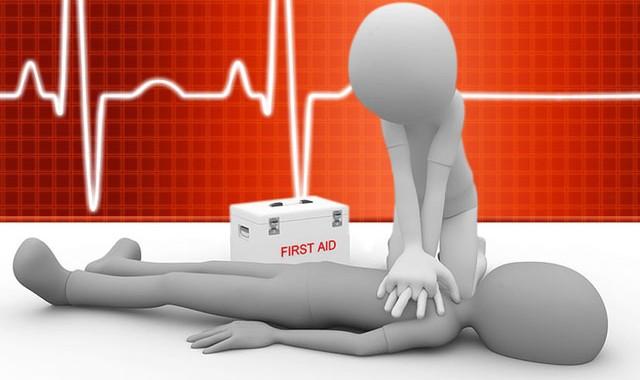
About Sudden Cardiac Arrest
DEFINITION
Sudden Cardiac Arrest (SCA) is an electrical malfunction of the heart that is immediate, and unexpected. This loss of heart function disrupts its pumping, stopping blood flow to the rest of your body.
SCA is NOT a heart attack, which is when a blockage limits blood flow to a portion of the heart. A heart attack can however trigger an electrical malfunction that leads to sudden cardiac arrest.
If not treated immediately, SCA can cause sudden cardiac death. Beginning cardiopulmonary resuscitation (CPR) or chest compressions can improve the chances of survival until emergency personnel arrive.
SYMPTOMS
SCA symptoms are immediate and life-threatening.
- Sudden Collapse
- Pulselessness
- Breathlessness
- Loss of Consciousness
Sudden cardiac arrest often provides no warning. Occasionally however, other signs precede SCA. Such may include dizziness, shortness of breath, weakness, vomiting, fatigue, fainting, chest pain, or palpitations.
CAUSES
The culprit of SCA is usually an abnormal heart rhythm problem called arrhythmia. The heart’s rhythm stimulator is called the sinus node and is located in the top right chamber (right atrium) of your heart. The sinus node is in control of generating rhythmic impulses that synchronize the heart rate and coordinate the pumping of the blood from the heart to the rest of your body. If something goes wrong with the sinus node, an arrhythmia can result. This means the beating of your heart is either too fast, too slow, or irregular. If the arrhthmia is serious enough, it can lead to sudden cardiac arrest.
The most common type of arrhythmia that leads to SCA is called ventricular fibrillation (v-fib). This is when a rapid, erratic rhythm impulse causes your heart ventricles to quiver instead of regularly pumping blood.
Heart conditions that can lead to sudden cardiac arrest include:
- Coronary Artery Disease
- Heart Attack
- Enlarged Heart (Cardiomyopathy)
- Valvular Heart Disease
- Congenital Heart Disease
- Electrical Heart Problems (ie: Brugada’s Syndrome or Long QT Syndrome)
RISK FACTORS
The same risk factors of coronary artery disease put you at risk for sudden cardiac arrest because they are so often linked. Risk factors include:
- Family History of Coronary Artery Disease
- History of Smoking
- High Blood Pressure
- High Cholesterol
- Obesity
- Diabetes
- Sedentary Lifestyle
- Excessive Alcohol Consumption (>1-2 drinks/day)
Other factors that could increase your risk of SCA include:
- Previous cardiac arrest or family history of SCA
- Previous heart attack
- Personal or family history of heart disease or rhythm disorders, heart defects, etc
- Age (>45 for men, >55 for women)
- Male gender (men are 2-3x more likely to experience SCA)
- Illegal drug use
- Nutritional imbalance (low potassium or magnesium)
COMPLICATIONS
The brain is the first organ to suffer when a sudden cardiac arrest occurs because it doesn’t have a reserve of oxygen-rich blood. It relies completely on an uninterrupted blood supply. It is the reduction of this supply that causes unconsciousness. If heart rhythm does not return rapidly to normal, brain damage occurs and dealth results. If SCA lasts more than 10 minutes, survival is rare. Survivors may show signs of brain damage.
TESTS & DIAGNOSIS
If you experience an episode of SCA and survive, your doctor will want to determine what caused the arrest. Tests may include: Electrocardiogram Blood Tests (Cardiac Enzyme, Electrolyte, Drug Test, Hormone Test) Imaging Tests (Echocardiogram, Ejection Fraction, Nuclear Scan) Electrophsiological Testing & Mapping Coronary Catheterization (Angiogram) TREATMENT & DRUGS SCA requires immediate action. Cardiopulmonary resuscitation (CPR) is an essential element in treating sudden cardiac arrest. CPR maintains a flow of oxygen-rich blood to the body’s vital organs while emergency personnel is en route.
IF YOU DON’T KNOW CPR AND SOMEONE COLLAPSES NEAR YOU, CALL 911 IMMEDIATELY. THEN, START PUSHING HARD AND FAST IN THE CENTER OF THE PERSON’S CHEST (100/MIN). PERFORM CPR UNTIL AN AUTOMATED EXTERNAL DEFIBRILLATOR (AED) BECOMES AVAILABLE.
Treatments include: Drugs (beta blockers, ACE inhibitors, calcium channel blockers) Implantable Cardioverter-Defibrillator (ICD) Coronary Angioplasty Coronary Bypass Surgery Radiofrequency Catheter Ablation Corrective Heart Surgery Heart Transplantation PREVENTION Reduce your risk of a sudden cardiac arrest by: Regular checkups with heart disease screens Don’t smoke Drink alcohol in moderation (<2 drinks/day) Eat a balanced, nutritious diet Stay physically active If you have a known high risk of SCA, you may consider purchasing an automated external defibrillator (AED) for home use. As always, discuss important decisions like this with your doctor before. If you live with someone who is at risk for SCA, become CPR trained. You could be a lifesaver